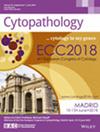Higher sensitivity of pericardial fluid cytology than biopsy in malignant effusions with potential explanation of false-negative cytology: A multi-institutional analysis
Abstract
Objective
Malignant pericardial effusions are associated with a poor prognosis. Pericardial fluid cytology and pericardial biopsy are the primary methods for diagnosis. This study aimed to conduct a multi-institutional analysis to compare the diagnostic sensitivity of cytology and biopsy, and to investigate potential explanations for false-negative results in cytology.
Methods
A retrospective review of pericardial fluid cytology cases with concurrent biopsy was conducted across four different institutions. Results were compared using standard statistical methods with attention to sensitivity and histologic distribution. False-negative cytology cases were investigated for further exploration.
Results
A total of 309 cases were collected, of which 99 (32.0%) were confirmed malignant through repeat sampling or clinical history. Pericardial fluid cytology and biopsy identified 84 and 64 malignant cases, respectively. Our findings confirmed significantly higher sensitivity of cytology compared to biopsy (84.8% vs 65.7%). The most common sites of origin were lung, breast, and gastrointestinal, with adenocarcinoma being the most prevalent histologic subtype. Histologic review of 12 false-negative cytology cases revealed three key explanations; lymphoma was the most common missed diagnosis (33.3%); fibrinous pericarditis obscures neoplastic cells on the pericardial surface; and pericardial involvement can be seen without extension into the pericardial space.
Conclusion
This study demonstrated diagnostic superiority of pericardial fluid cytology over biopsy in the evaluation of malignant pericardial effusions. We identified several limitations in fluid cytology causing false negatives. In the context of an underlying malignancy with pericardial effusion, pathologists should consider immunohistochemistry studies to aid on the diagnosis.


 求助内容:
求助内容: 应助结果提醒方式:
应助结果提醒方式:


